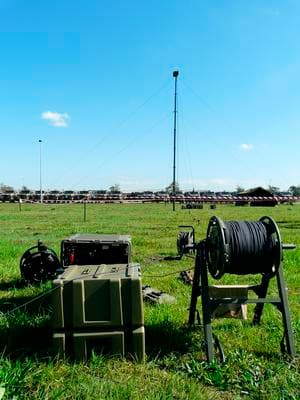Patrick Durrant | Brisbane
Last week Boeing Defence Australia conducted a demonstration of the digital battlespace network communications solution being delivered under Project Land 2072 Phase 2B at Damascus Barracks in Meeandah, Brisbane.
Attendees, including ADM, were updated on the project (informally known as Currawong) and given a tour of the array of communications equipment on display and set up for the purpose of the ninth site test since contract signature in September 2015. For some background on the project read ADM’s article published in November last year.
I don’t think we fully know yet how this will revolutionise the way we do headquarters
Boeing project director Lee Davis confirmed that the design phase had been completed, with formal testing underway and a field test for Army being planned for August this year. The hardware baseline is now in low rate initial production and the release 1 software is complete and in formal qualification testing.
“We have our hardware and software finalised, we’ve been doing a lot of dry run activity to exercise the system both in the lab and out in the field,” Davis said.
“The bearer systems are either in qualification testing or in formal acceptance and we’ve started transition for service introduction – there’s been a lot of engagement with 7CSR, 1SIG and 1CCS, the first three units to receive the system later this year.”
Currawong is performing well against schedule, though initial materiel release is now expected slightly later than originally anticipated (third quarter 2017) in the first quarter of 2018, with initial operating capability in mid-2018 and final operational capability in 2020.
Boeing’s local development of key components of the system, such as the Tactical Services Router, has resulted in technology that is world beating, according to CASG Director-General Communications Systems Myra Sefton, also in attendance at the demonstration.
With agility a key requirement, the Boeing team had to look for unique methods to reduce the weight and the footprint of the TSR. This essentially required eliminating air conditioning.

Part of the demonstration at Damascus Barracks in Brisbane. A field test of the system is planned for August.
Credit: ADM Patrick Durrant
“It has a heat sink design allowing passive cooling by passing airflow,” Davis said. “We’ve tested it successfully in up to 70 degrees of ambient temperature, and the processor is also generating heat so it’s roughly 105 degrees inside the box.”
Davis explained his team was able to leverage off the experience of Boeing’s Satellite Manufacturing Division in El Segundo in California.
“You can imagine the space environment is similarly harsh, while also demanding weight and space efficiency, so they helped to hone our design to get the TSR as small and compact as possible.”
ADM spoke with Major General (Retd) Michael Krause, who served as ISAF Deputy Chief of Staff in Afghanistan from 2011 to 2012, and now works part-time for Boeing as the strategic advisor (Land).
“I’ve been Lee’s greatest defender and harshest critic to make sure that he gets the stuff I wanted,” he said. “When I was a brigade commander, we had Parrakeet, so to see this is magnificent – I don’t think we fully know yet how this will revolutionise the way we do headquarters.
“For example, what we see today is in tents and static, but as soon as you go to mobile and protected it brings along all sorts of connotations.”
The second release of the project will deal with elements such as Headquarters-On-The-Move (HQOTM) and a Tropposcatter Communications System planned for Initial Materiel Release in 2020.
Davis explained the core ‘brick’ of the system, known as the Network Access Module (NAM), is planned for integration along with Wideband SATCOM into vehicles including the Bushmaster to provide the HQOTM capability; an EW variant of the Bushmaster (which has the necessary built–in power) was on display at the demonstration.
“All I know about SATCOM-on-the-move is that it can track slightly faster than this thing can go cross-country,” MAJGEN Krause said, pointing at the Bushmaster. “Put it this way – I don’t want a driver to try and beat the sat dish unless I’m evading enemy fire!”
He’s excited about the joint prospects offered by Currawong.
“The fact that Air Force is getting it gives us the first part of a joint operational network. There’s also no reason why this couldn’t go on an LHD, joining the joint ops room to shore. Once you have a single network rather than the disparate networks we have at the moment it brings so many efficiencies.”
MAJGEN Krause added they were already thinking of applications for the RAAF's E-7A Wedgetail.
“As soon as you have commonality of training, networks and equipment it just makes so much sense.”




